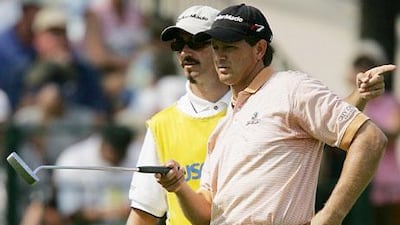Any notion of caddies having cushy jobs is so very last century.
"The more you do it, the longer you spend at the golf course," said Colin Byrne, the veteran caddie of the 21-year-old English wunderkind Tom Lewis.
"Everyone's looking for an edge, and I think everyone's afraid to leave the golf course."
One reason: "We're all influenced by what happens around us."
What happens around them nowadays is toil. Twenty years ago, Byrne said, some players traded on talent; now players trade on moderate talent plus diligence or considerable talent plus diligence. Even away from the course, they frequent hotel gyms alongside physios.
Byrne noticed the rigour upgrade with Swedish players in the 1990s (for yet another case of Swedish excellence).
The caddie's job thus has become "a lot more than the four to five hours on the course," bloating to more hours of driving ranges and practice rounds, hunting balance between practice and competition.
The yang might have trumped the yin sometimes, Byrne said, as when Padraig Harrington, his fellow Irishman, "finally admitted" that in golf's eternal mystery, he might have won more had he worked less.
Don't picture caddies standing in museums absorbing local culture.
The "old days" - you know, that 20th century - allowed for marginally more travel glamour and cultural edification, before so many people became so good that time grew so limited.
"I've come to South Africa," Byrne said from the tournament last week, "and I've come for work. I'm in a beautiful part of the world. I'm, you know, close to it, but I'm not really seeing it."
That "sense of being somewhere different" has grown fainter.
Some call them on-course psychologists.
"You know, you kind of get in the back door to a very big arena," said Byrne, who has written newspaper columns in Ireland.
"You know, because we're not skilled … There's no caddie school, no way to study it. It's probably something a lot of us have stumbled upon."
Then again, it is a hard to teach -and learn - art.
While discussing the two-time US Open champion Retief Goosen's brutal Sunday at the 2005 US Open, Byrne said: "Probably the art of caddying is understanding whom your dealing with, what would motivate him and what wouldn't motivate him.
"Some people need to be pumped up, and some need quiet words of encouragement."
"You can say the right thing and the wrong thing, even though it's the same thing and at the right time," Byrne said, likening it to how saying "Good morning" can work - or, not.
The job security amounts to …
"There's absolutely no security in the job," Byrne said, "which makes a very clean case if you're not getting on with the person or you're not doing your job. There's no contract.
"It keeps people with an eye on the job. It kind of makes you hungry, as well."
Unlike the slightly raffish days of yore, caddies must be more organised, more "stable", he said. They outnumber available jobs, so those just hoping to fill in would be more populous in tournament parking areas had mobile phones not enabled players in need to locate alternates.
And then, one quirk: "If the economy's doing badly, there are more caddies out here," Byrne said. "It's not an indicator you'd see in any financial papers, but it's not a bad one to look at."
But then, that soaring moment …
On a golden Sunday on Long Island, at the 2004 US Open in Shinnecock Hills, New York, as players bemoaned the barbaric course, Goosen edged Phil Mickelson even as the American tried to claim the first two majors on offer that year.
Upshot: Goosen won a road match, with a caddie who has worked for - at least - Goosen, Greg Turner, Paul Lawrie, Alex Noren, Edoardo Molinari, Lewis.
"Obviously it was a very hostile environment but I think that secretly helped Retief, because the harder you push him, the better he gets, the more obnoxious you get, the better he gets," Byrne said.
So: "He holes the final putt to win. Wasn't a fist pump. Was very simple. A double flip of the cap.
"For him that was probably a big thing, to flip his cap twice as opposed to doffing it.
"He did a double doff. Just the understatedness of it, that's what I like about him."
A guy in through the back door stood amid a huge moment that "justified all the times when you've caddied when you've lost money, or you've got absolutely no satisfaction out of it." His adjective: "indelible".

